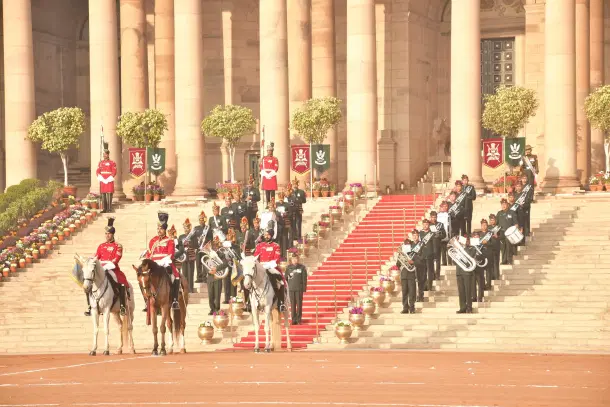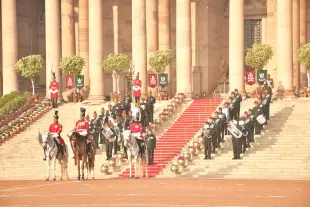Culture
Why We Must Reimagine The 'Colonial' Change Of Guard Ceremony
Anshika Agrawal
Jul 17, 2025, 12:22 PM | Updated 12:30 PM IST
Save & read from anywhere!
Bookmark stories for easy access on any device or the Swarajya app.


Every Saturday morning, usually at 7 AM, a ceremony unfolds at the forecourt of Rashtrapati Bhavan open for public viewing.
With the President’s Bodyguard in full regalia, the synchronised march of troops, and the military band echoing through Lutyens’ Delhi, the Change of Guard Ceremony is a 30-minute weekly ritual that marks the handover of duties between outgoing and incoming presidential guards.
To the casual onlooker or foreign tourist, it might appear as a timeless tradition. But as I stood watching the ceremony, I could not help but ask: Whose tradition is this, really?
According to the President’s Secretariat, the ceremony “goes beyond security, symbolising vigilance, discipline, tradition, and continuity.” While the Change of Guard presents itself as a dignified affair, peel back the layers of protocol and pageantry, and you find a troubling silence around its origins. According to the official narrative, it is a military tradition “whose origins are lost in antiquity.” However, a closer look reveals it is not antiquity we are dealing with, but an imperial legacy disguised as tradition.
The ceremony’s lineage can be traced directly to the British imperial machinery in India. In 1773, the East India Company established the President’s Bodyguard (PBG), now India’s oldest surviving regiment, not to serve an Indian republic, but the then colonial Governor-General. The uniforms, the cavalry, the inspection rituals, all were borrowed from British military customs and adapted to project imperial dominance.
After 1947, instead of being dismantled or indigenised, these rituals were simply repurposed. The Viceroy became the President, but the PBG remained unchanged. Its uniforms continued to echo British cavalry attire, and the structure, the inspection, handover, and bugle calls, continued to follow the choreography of colonial spectacle.
This continuation reflects what cultural theorist Ashis Nandy has termed the “intimate enemy”, the lingering presence of colonial logic within postcolonial governance.
If one were to ask what is “Indian” about the Change of Guard ceremony, beyond the nationality of the soldiers, there would be little to point to. The irony is hard to miss: a republic born out of anti-colonial struggle continues to celebrate a ceremonial form built to glorify colonial rule.
The Illusion of Tradition
Ceremonies, by their very nature, are powerful vessels of meaning. They offer rhythm to public life, signal transitions, and affirm shared values. But they are not immune to scrutiny, especially when their symbolism no longer aligns with the identity of the society that enacts them.
Rituals regulate emotion and social cohesion, but only when rooted in a community’s own cultural matrix. In this light, the Change of Guard becomes not a celebration of continuity, but an illusion of historical depth.
Political theorist Partha Chatterjee, in The Nation and Its Fragments, describes the postcolonial Indian state as a “derivative” state, one that claims sovereignty yet draws legitimacy from colonial structures.
Therefore, instead of being a dynamic cultural memory, these ceremonies function more like a museum piece still set to British standards, yet recited weekly at the heart of the Indian republic.
Defenders of the Change of Guard ceremony often cite its longevity or argue for the preservation of “tradition.” But this raises a critical question: What kind of India are we projecting, both to ourselves and to the world?
Decolonisation is a mindset, not a manual
In the era of media spectacle, these ceremonies are not just internal rituals, but global displays of cultural self-perception.
State power is now performed not through institutions alone, but through carefully curated images of legitimacy. India’s continued use of British ceremonial grammar signals borrowed authority, not civilisational confidence.
True decolonisation is not a linear process with a clear endpoint. It is a conscious reorientation of thought, a mental shift in how we relate to history, power, and identity. It is not about erasing history or denying the colonial past. It is about reclaiming the power to interpret and shape what we choose to carry forward. As long as our ceremonies continue to reek of our colonisers, we are celebrating not who we are, but who we were told to be.
A Missed Opportunity
Consider the changes made in recent years. President Pranab Mukherjee made the ceremony more accessible by shifting it to the front courtyard of Rashtrapati Bhavan. President Draupadi Murmu added musical performances to make it more engaging. In a 2023 interview, President Murmu stated that the goal was to “bring citizens closer to the grandeur of the Rashtrapati Bhavan.”
This raises a pressing question: If we have the agency to modernise the format for entertainment, why do we not have the imagination to indigenise it for cultural truth? Continuity without context is not preservation, it is performative stagnation.
Contrast this with Britain, which has successfully updated its own royal ceremonies. During the coronation of King Charles III in 2023, elements such as multi-faith blessings, women bishops, and diverse cultural symbols were introduced to reflect modern British identity. Even a monarchy has recognised the need to align ritual with present values. Why then does a republic like India hesitate to reimagine its own?
What Should a “Bharatiya” Ceremony Look Like?
To envision a Bharatiya version of the Change of Guard ceremony is not to indulge in romanticism or nostalgia. It is to ask a serious question: What does it mean for a sovereign republic to perform its identity on its own terms? If we accept that ceremonies are living narratives of collective values, then the way we design, structure, and stage them must reflect the spirit of the people, not just the legacy of power.
A reimagined Change of Guard could be a compelling example of ritual continuity with cultural transformation.
It could begin with a Vedic invocation, not for religious purposes, but as a civilisational gesture to invoke clarity, discipline, and protection.
The guards’ uniforms could be inspired by Indian martial traditions, from Maratha peshwa headgear to Rajput warrior cloaks to Ahom designs, or even textiles like Banarasi zari or Chola-style armour patterns adapted into ceremonial dress, symbolising the rich plurality of India's warrior history.
The music could blend traditional Indian instruments such as the shankh, dhol, nagaswaram, or rudra veena, soaked in Veer Rasa, creating a distinctly Indian auditory experience of state power.
Instead of purely Western-style salutes and foot drills, the very act of “guard change” could be accompanied by ritual gestures of respect, such as the namaskar, tilak, or symbolic passing of a staff or shastra (weapon), linking it to traditional ceremonies of power transition.
This is not about rejecting the military professionalism or discipline that the current ceremony reflects. It is about infusing it with meaning that reflects India's own worldview, one that sees duty not just as hierarchy and drill, but as seva (service), kartavya (responsibility), and dharma (righteous action).
In the form of Indian Knowledge Systems (IKS), we already have the lens to recover intellectual autonomy, to rethink how the Indian state expresses itself in public life. What we truly need is only the will to integrate them into institutions that matter.
The Symbolism of Change: Gestures That Mattered
Symbols are the language through which nations articulate who they are, where they have come from, and where they intend to go.
In recent years, we have seen a renewed interest in aligning state symbolism with Indian cultural consciousness.
The renaming of Rajpath (“King’s Way”) to Kartavya Path (“Path of Duty”) was one such act. The installation of the Sengol in the new Parliament building, a Tamil Chola-era sceptre symbolising righteous governance, marked another moment of cultural reclamation. In 2022, the unveiling of a new national emblem atop the Parliament sparked debate due to its more assertive, angular depiction of the Ashokan lions, signalling a confident departure from the softer colonial-era aesthetic.
These acts, while symbolic, represent a growing awareness that what we choose to represent in our public spaces reflects what we value as a nation. They signal a willingness to draw from India’s own civilisational traditions, from its philosophies and art to its statecraft and iconography, instead of relying on inherited colonial templates.
Yet, this same sensibility has not extended to the rituals of the state, particularly ceremonies like the Change of Guard or the Beating Retreat for that matter, which still carry the visual and structural DNA of British imperialism.
Anshika Agrawal is a public policy professional, passionate about exploring the intersections of Indian culture, knowledge systems and contemporary policy challenges.





